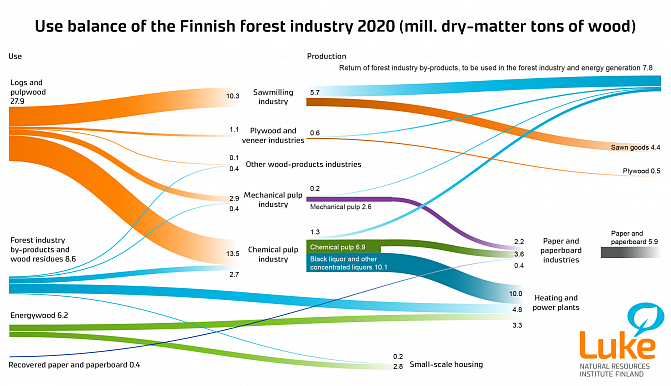Most of the wood dry-matter ends up to energy generation
In 2020, a total of 36.8 million tonnes of wood were used in Finland, measured as wood dry matter tied up in forest industry products, wood fuels and waste. Energy generation accounted for 58% of all wood dry-matter consumption. At the turn of the millenium, its share was a little less than half. Most of the wood dry-matter used in energy generation consist of forest industries by-products. The share of wood dry-matter tied up in forest industry products (such as paper and sawn goods), has decreased at the same time.
The volume of wood dry-matter consumed in heat and power plants has increased
In 2020 the total use of wood dry-matter decreased 6% from the previous year. Year 2018 and 2019 were both peak years in the consumption of wood.
– “The proportion of wood dry-matter consumed in energy generation has increased, and the increase is due to heat and power plants. The amount of wood consumed in small-scale housing has not changed significantly”, says Aarre Peltola, senior statistician at Luke.A total of 21.3 million tonnes of wood dry-matter were burned in energy generation in 2020. The usage of wood fuels can be classified as follows:- Black liquor and other concentrated liquors from pulp industry used for energy generation in heating and power plants (47% of all wood dry-matter used for energy generation).
- Solid wood fuels used in heating and power plants; mostly forest industry by-products, but also recycled wood and pellets. Wood residues burned in small-scale housing are mainly recycled wood (24%).
- Forest chips, logs of firewood and smallwood consumption in heating and power plants or in small-scale housing (29%).
The first two categories are reuse of wood dry-matter and the last one is use of wood dry-matter for the first time.
Wood dry-matter tied up in paper has decreased
A total of 15.0 million tonnes of wood dry-matter were tied up in forest industry products in 2020. This was 41% of all wood dry-matter consumed in Finland, and the share has declined gradually. At the turn of the millenium the proportion was 51%.
The clear change has taken place in printing and writing papers. In 2020, they accounted for only 6% of total wood dry-matter use. Their share was 18% at the turn of the millennium. The proportion of wood dry-matter tied up in sawn goods has also decreased. The proportion of dry-matter bound to wood pulp, on the other hand, has increased. This reflects an increase in pulp exports. The wood pulp consumed in Finland is raw material for the paper industry, and it is included in the figures for the paper industry.
In 2020, a total of 14.5 million tonnes of wood dry-matter, were exported from Finland. Of this, 13.8 million tonnes were forest industry products and 0.7 million tonnes roundwood and wood residues. A total of 6.5 million tonnes wood dry-matter were imported into Finland. This was mainly roundwood and wood residues.
Mass balance converts wood and forest industry products into a single unit of measurement
Use and mass balances represent the supply of wood and forest industry products from different sources and the flow of wood material from raw materials to products and energy generation.
In use balances, the use and supply of wood are measured in solid cubic metres and tonnes, while in mass balances these are converted into a single unit of measurement: dry-matter tons of wood. This makes it possible to present results that cover the entire sector using a single unit of measurement. Mass balances monitor how wood dry-matter is tied up in different forest industry products, wood fuels and waste.



